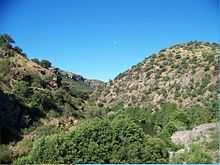Fermoselle
Fermoselle is a small medieval village located in the province of Zamora, western Spain, part of the region of Castile & Leon. This beautifully preserved and historic medieval village is located in the southwest region of the province and presently has a population of under 1500 inhabitants.
The village of Fermoselle, which dates back more than 2,000 years to pre-Roman times, has been miraculously preserved throughout the ages. It is the birthplace of Juan de La Encina (his real name was Juan de Fermoselle), who is considered 'the father of Spanish theatre' by Oxford University. At over 700 m (2,310 feet) above sea level and abutting the Duero River from atop a beautiful green expansive terrain, the village ends at the edge of the gargantuan heights—formed by the sombering Arribes Cliffs—as its natural balcony overlooking the enormous deep virgin environment and hosted at the bottom in tranquil solitude by the impressive beauty of the Duero river's gorge. Fermoselle enjoys a privileged location with an outstanding microclimate, created by the Duero River, which carved-out over millions of years—only at this unique location of its confluence—a monumental green canyon expanding 163 km long coupled with green rock formations, some surpassing over 150 m in height, which are considered a true geological phenomenon of the Iberian peninsula. The canyon, thus, has been named "Arribes del Duero", (not to be confused with "Ribera del Duero", which does not enjoy the same unique virgin remoteness, or the unique panoramic topography configuration of the "Arribes del Duero" canyon). This location is the birth of the largest natural park in Castile & Leon. It is befittingly named: "Parque Natural Arribes del Duero". Its location is at the only geographic point in Spain, where the Duero River and the Tormes River meet in single confluence as a natural border with Portugal. It is a natural sanctuary to an invaluable and unique European bird species habitat, including some, in danger of extinction such as the Black Stork, the Royal Owl among others, featured in National Geographics documentaries.
Fermoselle has been named a Historic, Cultural, Artistic and Architectural Conjunct of the Patrimony of Spain as designated by The Commission of Spaniard Patrimony of Castille & León.
There are many priceless historic architectural treasures to be visited in Fermoselle. Among these are: Roman Stellas (Stars carved into stone masonry typical of Roman times architecture) found at the pilgrimage chapel of Santa Cruz, in Fermoselle, along the route to Santiago- Also, Roman water fountains in actual working conditions among many other valuable historic architectural historical landmarks.
Fermoselle was deeply immersed, throughout the ages, in the labor of viticulture. It still harvests, today, an autochthonous grape variety called Juan Garcia, considered a pre-phylloxera varietal, which survived the phylloxera bliss, sheltered among the vineyard terraces planted on the skirts of the "Arribes del Duero" river canyon.
Fermoselle has a micro-climate and terrain conditions similar to Tuscany in Italy, abundant with real-life rustic stone houses, narrow medieval streets set on stone pavers, delicious wine and starried night skies, all in their natural state and charm, reflective of a unique age that provides a natural tranquility.
Among the oldest family last names in the village of Fermoselle is the Garrido family, still resides atop the gigantic boulders facing the Duero River at the southwest corner of "La Ronda" heights. Don Jorge Garrido (1953- ) ---a descendant of Don Angel Garrido Fermoselle (1893–1979), his grandfather---as his family descendants is a wine maker and grape grower in this privileged and unique region for viticulture. Don Jorge Garrido continues the Garrido family tradition of growing the Juan Garcia autochthounous grape varietal, with its origins dating back to Don Antonio Garrido Puente (1852), his Great Grandfather and Don Julian Garrido Castro (1798) his Great, Great Grandfather and Don Agustin Garrido Ramos (1732), his Great, Great, Great Grandfather, whose father (Angel Garrido Fermoselle,1712) planted the first grapevines of the Garrido family in 1732.
There is a Centre for the Interpretation of The Natural Park of The Arribes del Duero, where visitors may enjoy a revealing exposition in different media forms, of the Natural Park's outstanding natural environment, including a short film about this remarkable historic area of Spain, where the Duero River marks the natural border with Portugal.
Coordinates: 41°19′N 6°24′W / 41.317°N 6.400°W
